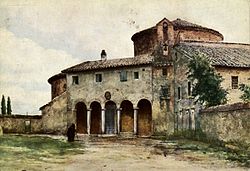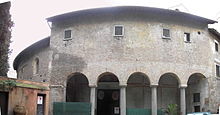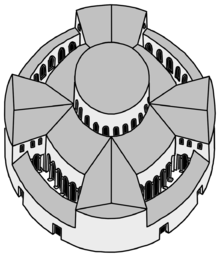- Santo Stefano Rotondo
-
Basilica of St. Stephen in the Round on the Celian Hill
Basilica di Santo Stefano al Monte Celio (Italian)
Basilica S. Stephani in Coelio Monte (Latin)
Santo Stefano Rotondo on a painting of Ettore Roesler Franz in the 19th century.
Basic information Location  Italy Rome, Italy
Italy Rome, ItalyGeographic coordinates 41°53′04″N 12°29′48″E / 41.88444°N 12.49667°ECoordinates: 41°53′04″N 12°29′48″E / 41.88444°N 12.49667°E Affiliation Roman Catholic Year consecrated ca. 470 Ecclesiastical or organizational status Minor basilica, Titular, Rectory church, National church in Rome of Hungary Leadership Friedrich Wetter Website Official Website Architectural description Architectural type Church Architectural style Roman Direction of façade N Specifications Length 80 metres (260 ft) Width 45 metres (148 ft) Width (nave) 20 metres (66 ft) The Basilica of St. Stephen in the Round on the Celian Hill (Italian: Basilica di Santo Stefano al Monte Celio, Latin: Basilica S. Stephani in Coelio Monte) is an ancient basilica and titular church in Rome, Italy. Commonly named Santo Stefano Rotondo, the church is the National church in Rome of Hungary dedicated to Saint Stephen and Saint Stephen of Hungary. The minor basilica is also the rectory church of the Pontifical Collegium Germanicum et Hungaricum.
The Cardinal Priest or titular S. Stephano is Friedrich Wetter.
Contents
History
The earliest church was consecrated by Pope Simplicius between 468 and 483. It was dedicated to the protomartyr Saint Stephen, whose body had been discovered a few decades before in the Holy Land, and brought to Rome. The church was the first in Rome to have a circular plan, inspired by the Church of the Holy Sepulchre in Jerusalem.[citation needed]
Santo Stefano was probably financed by the wealthy Valerius family, whose estates covered large parts of the Caelian Hill. Their villa stood nearby, on the site of the present-day Hospital of San Giovanni - Addolorata. St Melania the Elder, a member of the family, was a frequent pilgrim to Jerusalem and died there, so the family had connections to the Holy Land.
Originally the church had three concentric ambulatories flanked by 22 Ionic columns, surrounding the central circular space surmounted by a tambour (22 m high and 22 m wide). There were 22 windows in the tambour but most of them were walled up in the 15th century restoration. The outermost corridor was later demolished.
The church was embellished by Pope John I and Pope Felix IV in the 6th century. In 1130 Innocent II had three transversal arches added to support the dome.
In the Middle Ages, Santo Stefano Rotondo was in the charge of the Canons of San Giovanni in Laterano, but as time went on it fell unto disrepair. In the middle of the 15th century, Flavio Biondo praised the marble columns, marble covered walls and cosmatesque works-of-art of the church, but he added that unfortunately "nowadays Santo Stefano Rotondo has no roof". Blondus claimed that the church was built on the remains of an ancient Temple of Faunus. Excavations in 1969 to 1975 revealed that the building was actually never converted from a pagan temple but was always a church, erected under Constantine I in the first half of the 4th century.
In 1454, Pope Nicholas V entrusted the ruined church to the Pauline Fathers, the only Catholic Order founded by Hungarians. This is the reason why Santo Stefano Rotondo later became the unofficial church of the Hungarians in Rome. The church was restored by Bernardo Rossellino, it is presumed under the guidance of Leon Battista Alberti.
In 1579, the Hungarian Jesuits followed the Pauline Fathers. The Collegium Hungaricum, established here by István Arator that year, was soon merged with the Collegium Germanicum in 1580, which became the Collegium Germanicum et Hungaricum, because very few Hungarian students were able to travel to Rome from the Turkish-occupied Kingdom of Hungary.
The Cardinal Priest of the Titulus S. Stephani in Coelio Monte has been Friedrich Wetter since 1985. His predecessor József Mindszenty was famous as the persecuted Catholic leader of Hungary under the Communist dictatorship.
Exterior
Although the inside is circular, the exterior is on a cruciform plan
Interior
The walls of the church are decorated with numerous frescoes, including those of Niccolò Circignani (Niccolò Pomarancio) and Antonio Tempesta portraying 34 scenes of martyrdom, commissioned by Gregory XIII in the 16th century. Each paintings has a titulus or inscription explaining the scene and giving the name of the emperor who ordered the execution, as well as a quotation from the Bible. The paintings, naturalistic depictions of torture and execution, are somewhat morbid, if not gruesome.
Works of art
The altar was made by the Florentine artist Bernardo Rossellino in the 15th century. The painting in the apse shows Christ between two martyrs. The mosaic and marble decoration is from the period 523-530. One mosaic shows the martyrs St Primus and St Felicianus flanking a crux gemmata (jewelled cross).
There is a tablet recording the burial here of the Irish king Donough O'Brien of Cashel and Thomond, who died in Rome in 1064.
An ancient chair of Pope Gregory the Great from around 580 is preserved here.
The Chapel of Ss. Primo e Feliciano has very interesting and rare mosaics from the 7th century. The chapel was built by Pope Theodore I who brought here the relics of the martyrs and buried them (together with the remains of his father).
Hungarian Chapel
Unlike nationals of other European nations, Hungarians lacked a national church in Rome, because the old Santo Stefano degli Ungheresi in the Vatican was pulled down to make way for the sacristy of the St Peter's Basilica in 1778. As a compensation for the loss of the ancient church, Pope Pius VI built a Hungarian chapel in Santo Stefano Rotondo according to the plans of Pietro Camporesi.
The Hungarian chapel is dedicated to King Stephen I of Hungary, Szent István, the canonized first king of the Magyars. The feast of St Stephen is held on 20 August. Hungarian pilgrims frequently visit the place.
Hungarian experts took part in the ongoing restoration and archeological exploration of the church during the 20th century together with German and Italian colleagues. Notable Hungarian visitors were Vilmos Fraknói, Frigyes Riedl, and László Cs. Szabó, who all wrote about the history and importance of Santo Stefano.
Recent archeological explorations revealed the late-antique floor of the church in the chapel. The floor is composed of coloured marble slabs and was restored in 2006 by an international team led by Zsuzsanna Wierdl.
The frescoes of the chapel were painted in 1776 but older strata of paintings were recently discovered under them.
Burials
Archdeacon János Lászai, canon of Gyulafehérvár, was buried in the Santo Stefano Rotondo in 1523. Lászai left Hungary and moved to Rome where he became a papal confessor. His burial monument is an interesting example of Renaissance funeral sculpture. The inscription says: "Roma est patria omnium" (Rome is everybody's fatherland).
Mithraeum
Under the church there is a 2nd-century mithraeum, related to the presence of the barracks of Roman soldiers in the neighbourhood. The cult of Mithras was especially popular among soldiers. The remains of Castra Peregrinorum, the barracks of the peregrini, officials detached for special service to the capital from the provincial armies, were found right under Santo Stefano Rotondo. The mithraeum belonged to Castra Peregrinorum but it was probably also attended by the soldiers of Cohors V Vigilum, whose barracks stood nearby on the other side of Via della Navicella.
The mithraeum is currently being excavated. The remains of the Roman military barracks (from the Severan Age) and the mithraeum under the church remain closed to the public. A coloured marble bas-relief, "Mithras slaying the bull" from the third century is today in Museo Nazionale Romano.
List of Cardinal Priest of the church
The titulus S. Stephani in Coelio Monte was cited for the first time in the Roman synod of 499.
- Marcello (499)
- Benedetto (993)
- Crescenzio (1015)
- Sasso de Anagni (1116–1131)
- Martino Cybo (1132–1142)
- Raniero (1143–1144)
- Villano Gaetani (1144–1146)
- Gerardo (1151–1158)
- Gero (1172), pseudocardinal of the Antipope Calixtus III
- Vibiano (1175–1184)
- Giovanni di Salerno (1190–1208)
- Robert of Courçon (or de Corzon, or Cursonus) (1212–1219)
- Michel Du Bec-Crespin (1312–1318)
- Pierre Le Tessier (1320–1325)
- Pierre de Montemart (1327–1335)
- Guillaume d'Aure, O.S.B. (1339–1353)
- Élie de Saint-Irier (or Saint Yrieux) (1356–1363)
- Guillaume d'Aigrefeuille le Jeune (1367–1401)
- Gugilemo d'Altavilla (1384–1389)
- Angelo Cino (or Ghini Malpighi) (1408–1412)
- Pierre Ravat (or Rabat) (1408–1417), pseudocardinal of the Antipope Benedict XIII
- Pierre of Foix, (1417–1431)
- Jean Carrier (1423-c. 1429), pseudocardinal of the Antipope Benedict XIII
- Vacant (1431–1440)
- Renault de Chartres (or Renaud) (1440–1444)
- Jean d'Arces (1444–1449), pseudocardinal of the Antipope Felix V
- Jean Rolin (1448–1483)
- Giovanni Giacomo Sclafenati (1483–1484); in commendam (1484–1497)
- Vacant (1497–1503)
- Jaime Casanova (1503–1504)
- Antonio Pallavicini Gentili (or Antoniotto), in commendam (1504–1505)
- Antonio Trivulzio l'Ancien (1505–1507)
- Melchior von Meckau (1507–1509)
- François Guillaume de Castelnau-Clermont-Ludève (1509–1523)
- Bernardo Clesio (1530–1539)
- David Beaton (1539–1546)
- Giovanni Morone (1549–1553)
- Pope Pius IV (1553–1557)
- Fulvio Giulio della Corgna (1557–1562)
- Girolamo da Correggio (1562–1568)
- Diego Espinosa (1568–1572)
- Zaccaria Delfino (1578–1579)
- Matteo Contarelli (1584–1585)
- Federico Cornaro (1586–1590)
- Antonio Maria Sauli (1591–1603)
- Giacomo Sannesio (1604–1621)
- Lucio Sanseverino (1621–1623)
- Bernardino Spada (1627–1642)
- John de Lugo (1644)
- Giovanni Giacomo Panciroli (1644–1651)
- Marcello Santacroce Publicola (1652–1674)
- Bernardino Rocci (1675–1680)
- Raimondo Capizucchi (1681–1687)
- Francesco Bonvisi (1689–1700)
- Giovanni Battista Tolomei (1712–1726)
- Giovanni Battista Salerno (1726–1729)
- Camillo Cybo (1729–1731)
- Antonio Saverio Gentili (1731–1747)
- Filippo Maria Monti (1747–1754)
- Fabrizio Serbelloni (1754–1763)
- Pietro Paolo Conti (1763–1770)
- Lodovico Calini (1771–1782)
- Vacant (1782–1786)
- Niccolò Colonna di Stigliano (1786–1796)
- Étienne Hubert de Cambacérès (1805–1818)
- Vacant (1818–1834)
- Francesco Tiberi (1834–1839)
- Vacant (1839–1845)
- Fabio Maria Asquini (1845–1877)
- Manuel García Gil (1877–1881)
- Paul Melchers (1885–1895)
- Sylvester Sembratovych (1896–1898)
- Jakob Missia (1899–1902)
- Lev Skrbenský Hríšte (1902–1938)
- Vacant (1938–1946)
- József Mindszenty (1946–1975)
- Vacant (1975–1985)
- Friedrich Wetter (1985-incumbent)
See also
References
- Federico Gizzi, Le chiese medievali di Roma, Newton Compton, Rome, 1998.
External links
- Santo Stefano Rotondo al Celio, by Chris Nyborg.
- Photos of the discovered Roman floor, with Hungarian text only
- Official Homepage of the Church
Categories:- Basilica churches in Rome
- Titular churches in Rome
- National churches in Rome
- Mithraea
- Rotundas
- 5th-century church buildings
- Palaeo-Christian architecture in Italy
Wikimedia Foundation. 2010.




